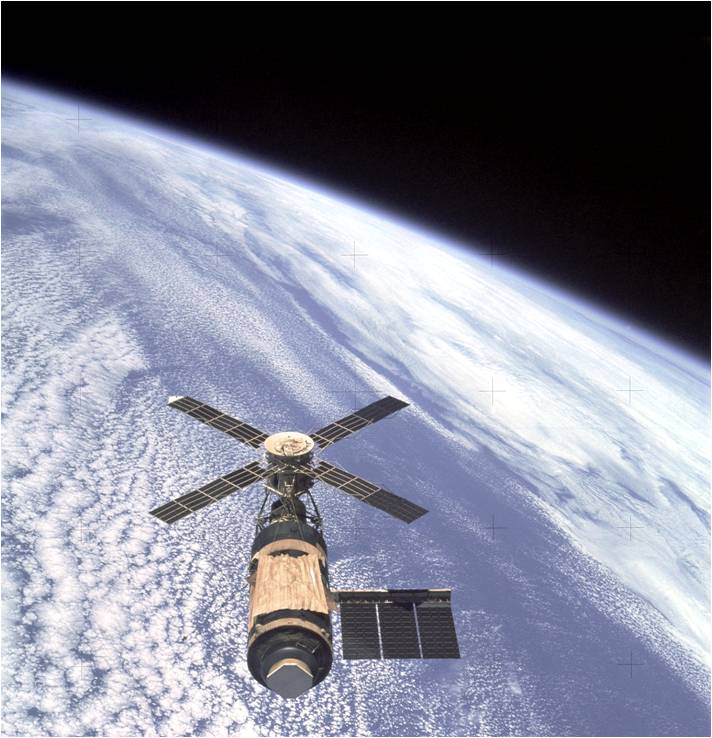Thirty-seven years ago this week, astronauts Pete Conrad, Joe Kerwin and Paul Weitz became the first NASA crew to fly aboard the recently-orbited Skylab space station. Not only would the crew establish a new record for time in orbit, they would effect critical repairs to the space station which had been seriously damaged during launch.
Skylab was America’s first space station. The program followed closely on the heels of the historic Apollo lunar landing effort. Skylab provided the United States with a unique space platform for obtaining vast quantities of scientific data about the Earth and the Sun. It also served as a means for ascertaining the effects of long-duration spaceflight on human beings.
A Saturn IVB third stage served as Skylab’s core. This huge cylinder, which measured 48-feet in length and 22-feet diameter, was modified for human occupancy and was known as the Orbital Workshop (OWS). With the addition of a Multiple Docking Adapter (MDA) and Airlock Module (AM), Skylab had a total length of 83-feet.
Skylab was also outfitted with a powerful space observatory known as the Apollo Telescope Mount (ATM). This unit sat astride the MDA and was configured with a quartet of electricity-producing solar panels. The OWS had a pair of solar panels as well. The entire Skylab stack weighed 85 tons.
The Skylab space station (Skylab 1) was placed into a 270-mile orbit using a Saturn V launch vehicle on Monday, 14 May 1973. Upon reaching orbit, it quickly became apparent that all was far from well aboard the space station. The micro-meteoroid shield and solar panel on one side of the OWS had been lost during ascent. The other OWS solar panel was stuck and did not deploy as planned.
With the loss of an OWS solar panel, Skylab would not have enough electrical energy to conduct its mission. The station was also heating up rapidly (temperatures approached 190 F at one point). The lost micro-meteoroid shield also provided protection from solar heating. Sans this protection, internal temperatures could rise high enough to destroy food, medical supplies, film and other perishables and render the OWS uninhabitable.
NASA engineers quickly went to work developing fixes for Skylab’s problems. A mechanism was invented to free the stuck solar panel. A parasol of gold-plated flexible material, deployed from an OWS scientific airlock, was then fashioned and tested on the ground. This material would cover the exposed portion of the OWS and provide the needed thermal shielding.
The onus was now on the Skylab 2 crew of Conrad, Kerwin and Weitz to implement the requisite fixes in orbit. On Friday, 25 May 1973, the Skylab 2 crew and their Apollo Command and Service Module (CSM) were rocketed into orbit by a Saturn IB launch vehicle. They quickly rendezvoused with Skylab and verified its sad condition. It was time to get to work.
The first order of business was to try to free the stuck solar panel. As Conrad flew the CSM in close proximity to Skylab, Kerwin held Weitz by the feet as the latter leaned out of the open CSM hatch and attempted to release the stuck solar panel with a pair of special cutters. No joy in spaceville. The solar panel refused to deploy.
The Skylab 2 crew next attempted to dock with Skylab. They tried six times and failed. The CSM drogue and probe was not functioning properly. The crew had to fix it or go home. With great difficulty, they did so and were finally able to dock with Skylab. The objective now was to enter Skylab and deploy the parasol thermal shield.
With Conrad remaining in the CSM, Kerwin and Weitz sported gas masks and cautiously entered Skylab. The temperature inside of the OWS was 130 F. Fortunately, the air was found to be of good quality and the pair went to work deploying the thermal shield through a scientific airlock. The deployment was successful and the temperature started to slowly fall.
It would not be until Thursday, 07 June 1973 that the stuck solar panel finally would be freed. On that occasion, Conrad and Kerwin donned EVA suits and spent 8 hours working outside of Skylab. Their initial efforts with the cutters were unsuccesful.
Undeterred, Conrad and Kerwin improvised and were able to cut the strap that restrained the solar panel. Then, heaving with all their might, the pair finally freed the solar panel. In obedience to Newton’s 3rd Law, as the solar panel deployed in one direction, the astronauts went flying in the other. Happily, they were able to collect themselves and safely reenter the now adequately-powered Skylab.
Skylab 2 went on to spend 28 days in orbits; a record for the time. This record was quickly eclipsed by the Skylab 3 and Skylab 4 crews which spent 59 and 84 days in space, respectively. Skylab was an unqualified success and provided a plethora of terrestrial, solar and human factors data of immense importance to space science. These data played a vital role in the design and development of the ISS.
Skylab was abandoned following the Skylab 4 mission in February of 1974. The plan was to reactivate it and raise its orbit using the Space Shuttle when the latter became operational. Unfortunately, a combination of a rapidly deteriorating orbit and delays in flying the Shuttle conspired against bringing this plan to fruition. Skylab reentered the Earth’s atmosphere and broke-up near Australia in July of 1979.


